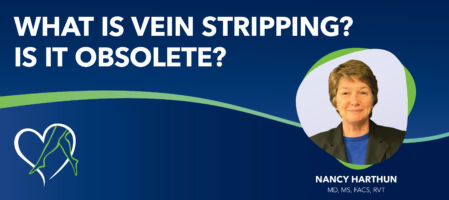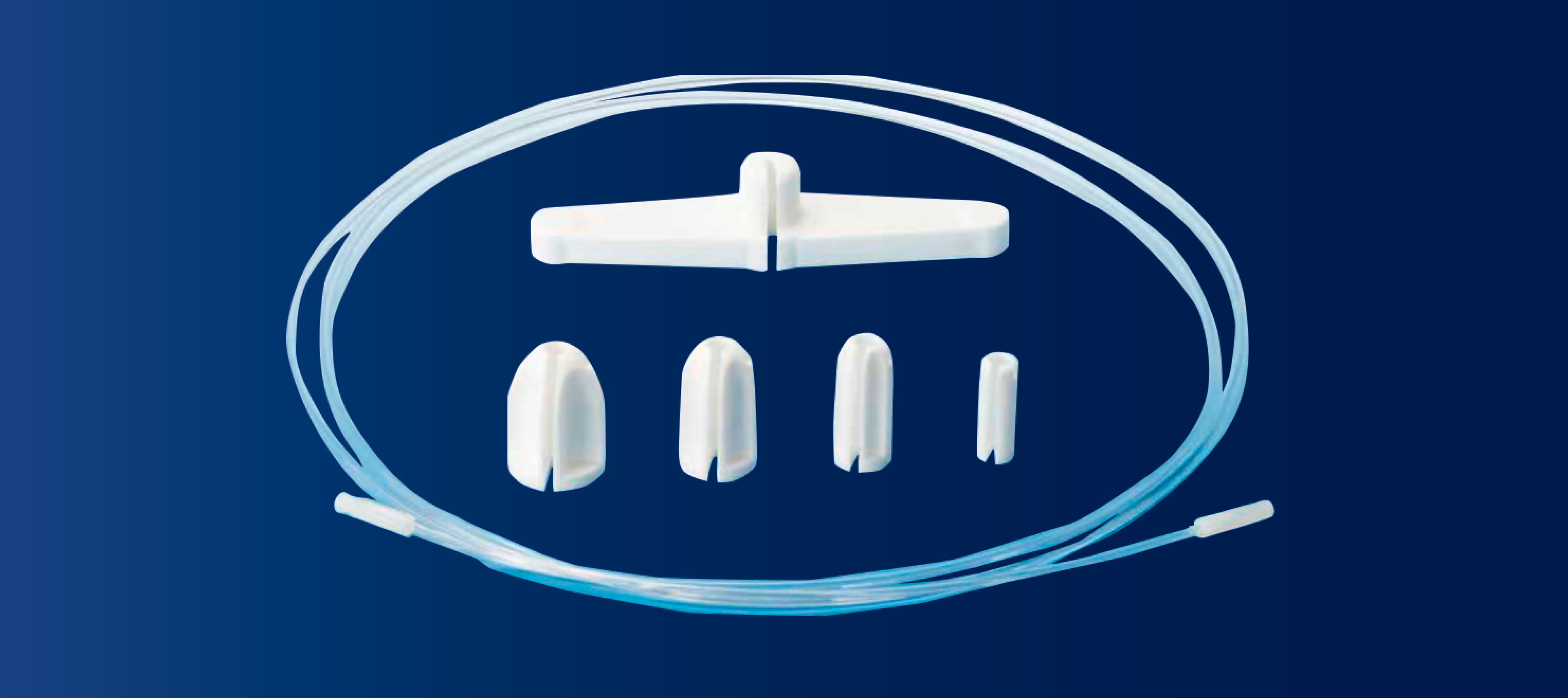
Vein stripping, once a common treatment option for venous insufficiency, has been replaced by less invasive, effective treatments. Learn more about the advanced outpatient solutions for problem leg veins from an experienced board-certified vein physician.
Medically reviewed by Nancy L. Harthun, MD, MS, FACS, RVT, on December 19, 2024.
For many years, vein stripping was considered the standard procedure for the treatment of venous insufficiency, a condition that afflicts countless individuals worldwide. This surgical technique involved physically removing problematic veins from the legs, and while it was effective, it came with numerous drawbacks, including long recovery times and significant pain.
Fortunately, advancements in medical technology have paved the way for a slew of effective, nearly pain-free, minimally invasive treatment options. In this blog, we will explore why vein stripping is less popular than it once was and which modern vein treatment options have replaced it.
We spoke to Nancy L. Harthun, MD, MS, FACS, RVT, lead physician at the Center for Vein Restoration (CVR) vein clinic location in Fort Wayne, Indiana.
Dr. Harthun: "Vein stripping has been around for a fairly long time. It was one of the first ways we developed to treat significant venous insufficiency."
Vein stripping is a surgical procedure used to remove or tie off a large vein in the leg, typically the greater saphenous vein. Vein stripping is usually performed under general or spinal anesthesia and may take about 1 to 1 1/2 hours. During the procedure, the affected veins are removed to relieve symptoms such as pain, swelling, and skin changes caused by varicose veins.
"Vein stripping was certainly more of a commitment (than the more modern treatments). Patients had to come to a surgery center or a hospital center for general anesthetic. And patients couldn't drive themselves home…It is more invasive. There's no question vein stripping is more invasive."- Dr. Nancy Harthun
Dr. Harthun: "A small nick is made in the vein, and a flexible plastic catheter is inserted. The doctor pushes the catheter up to the level of the hip, where the greater saphenous vein can be felt through the skin in almost everybody. That's where the doctor centers another small incision…

The patient must have a major anesthetic to tolerate the next part. You cannot get that area numb enough locally to remove the vein using this method. The physician cuts the vein in two at both ends and ties it off so you don't have any bleeding. And then, with the handle, the surgeon pulls the button through the course of the saphenous vein.
That button causes the vein to imbricate itself (overlapping successive layers of tissue in the surgical closure of a wound), and the surgeon physically removes the vein that way. The plus side is that it separates all the branches off the saphenous vein. The downside is it makes a fairly big tunnel. That whole course is sore and inflamed for a while.
When I performed vein stripping, I would squeeze all the blood out of the leg and put a tourniquet on the top to reduce the bleeding when all those branches were severed, but a lot of surgeons did not do that. Subsequently, the patient would end up with significant bruising because of that."
Dr. Harthun: "I'm going to take one small step back from calling vein stripping obsolete. I think it has largely been replaced by new technologies that are much better. I would reserve vein stripping for one clinical scenario: when a patient has a venous aneurysm in the greater saphenous vein. This is a vein about the size of a golf ball or bigger. Normally, it should be about the size of a pencil, so you can understand that that's almost two times as big as it should be.
Aneurysms can allow large blood clots to form. And if it's close to where the saphenous vein meets the deep system, there could be significant health consequences if that clot breaks off. So, we can't treat that less invasively and need to remove the vein. Vein stripping is an effective way of dealing with the rare circumstance of treating a greater saphenous venous aneurysm. Again, those are quite rare. Otherwise, vein stripping has been largely replaced by our better technologies."
It's Invasive
One of the primary reasons why vein stripping has lost its appeal is its invasive nature. During the procedure, the surgeon makes an incision in the leg and physically removes the problematic vein, typically the saphenous vein. This invasiveness often results in longer recovery periods, increased discomfort, and a higher risk of complications.
Scarring
The incisions made during vein stripping can leave unsightly scars. Many patients are understandably concerned about the cosmetic impact of the procedure, which can lead to reduced self-esteem and confidence.
Recovery Time Can Be Long
Patients who undergo vein stripping typically require an extended recovery period. They may need to take time off work and limit their activities for several weeks or even months. This inconvenience often deters individuals from seeking treatment.
Risk of Complications
Potential complications associated with vein stripping can include poor wound healing, infection, blood clots, and nerve damage, among others. As a result, the risks associated with the procedure have made it less attractive to both patients and healthcare providers. In addition, as Dr. Harthun mentioned, some surgeons do not make an effort to squeeze the blood out of the area, leaving these patients with significant bruising that is tender to the touch and could take weeks to fade.
Another reason for the decline of vein stripping is the advancement in diagnostic tools. Modern methods such as Doppler ultrasound allow for more accurate and non-invasive diagnosis of venous insufficiency. This precision helps healthcare providers tailor treatment plans to the individual patient's needs.
Modern treatment options for venous disease offer benefits such as reduced recurrence of problem veins and improved overall quality of life, including decreased post-procedure pain and bruising. Today's minimally invasive treatment options for varicose vein disease are performed as an outpatient in a comfortable office setting.
Endovenous ablation techniques have emerged as the go-to treatment for venous insufficiency. These minimally invasive procedures, such as endovenous laser therapy (EVLT) and radiofrequency ablation (RFA), involve using heat energy to seal off and collapse the problematic vein.
Advantages:
Sclerotherapy has become another popular choice for treating venous insufficiency. In this procedure, a specialized solution is injected directly into the problematic veins. This solution causes the veins to collapse and eventually be reabsorbed by the body.
Advantages:
Endovenous glue closure is another innovative treatment modality. It involves using a medical adhesive to close off the diseased vein. The procedure is minimally invasive and can often be completed in an outpatient setting.
Advantages:
Compression therapy involves wearing specialized stockings or wraps that apply gentle pressure to the legs. While not a direct treatment for venous insufficiency, it is often used with other modalities to manage symptoms and prevent the condition from worsening.
Advantages:
Except for the rare scenario in which a patient has a venous aneurysm in the greater saphenous vein, vein stripping is no longer the procedure of choice for treating venous insufficiency. Thanks to advancements in medical technology and the development of minimally invasive treatment modalities, patients now have a range of highly effective and less invasive options. These alternatives offer shorter recovery times, reduced scarring, and minimal discomfort, making them more appealing to patients and healthcare providers.
Center for Vein Restoration (CVR) is the largest physician-led national vein clinic offering personalized outpatient vein treatment options focused on helping our patients return quickly to an active lifestyle. As a result, individuals suffering from venous insufficiency can look forward to a brighter and less invasive future in their journey to better vein health.
CVR's caring and compassionate staff is dedicated to helping people with vein issues, providing detailed treatment plans, and handling all insurance paperwork. CVR accepts many insurances, including Aetna, Amerigroup, Anthem, Blue Cross/Blue Shield, Cigna, MultiPlan, Medicaid, Medicare, and more.
Call 240-965-3915 to speak to a Patient Services Representative or schedule your consultation online at a CVR near you today.
